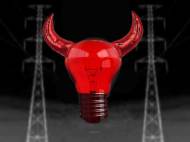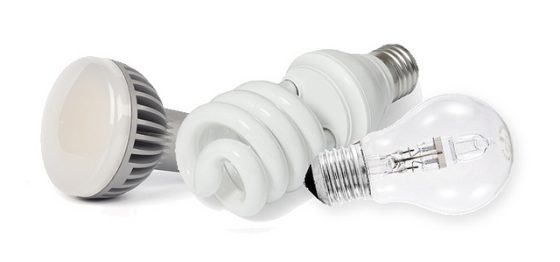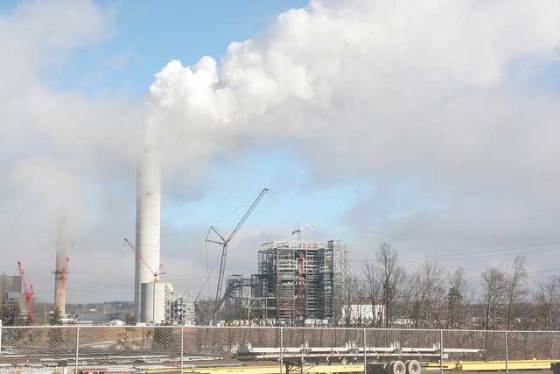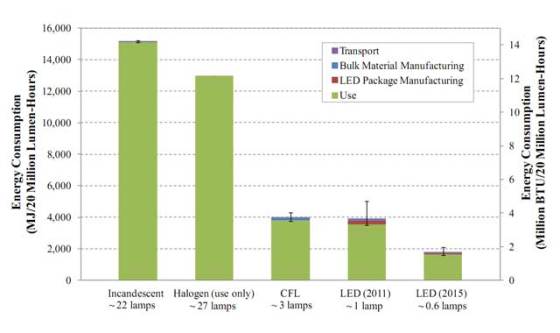Power consumption and environmental impact of light bulbs
 There are many claims and essentially press releases published by companies where they talk about advantage of lighting technologies they produce, and this article will provide the overall conclusion with facts many of those press releases don’t state. The article will be focused on 3 dominant types of lighting at the moment – incandescent, LED, and CFLs – and it will reveal their overall impact on our environment through their whole cycle.
There are many claims and essentially press releases published by companies where they talk about advantage of lighting technologies they produce, and this article will provide the overall conclusion with facts many of those press releases don’t state. The article will be focused on 3 dominant types of lighting at the moment – incandescent, LED, and CFLs – and it will reveal their overall impact on our environment through their whole cycle.
Unlike other articles where you might have read about certain aspects of a lighting technology, this article covers all the important aspects of a light bulb – ranging from materials needed for its manufacture, to its production, lifespan, and power consumption. Bear in mind that despite the facts same lighting production technologies employ different manufacturing approaches and power generation methods vary in different countries, the overall data leads to the same conclusion.
Light bulb components and the materials used for their production
Light bulb manufacture varies between companies and the presented information will be generalized. All 3 types of light bulb types require usage of tinplate steel for the Edison screw, and all CFLs and incandescent types of light bulbs require copper, solder and insulate in their base assembly, whereas LED bulbs require additional porcelain material.
While incandescent light bulbs don’t require any ballast or drivers, both CFLs and LED bulbs require different types of printed circuit boards, resistors, transistors, inductors, capacitors, diodes and copper wire which make the bulky base of those bulbs. LEDs require additional Teflon tubing which improves the insulation of the circuit in order to prolong its operation according to their projected lifespan. Optics of all 3 types of lighting relies on different types of glass, whereas LED bulbs require additional plastics.
Major difference is present in the technology the bulbs rely on to produce light. CFLs require usage of mercury as a glowing gas, electrodes as the filament, as well as plastic, glass, and copper wire for its housing. A similar type of housing and same materials are required by LED bulbs, while they use LED module to provide the light and it consists out of LED die, aluminum, plastics, and copper wire. Incandescent light bulbs are fairly simpler and require Tungsten as a filament. Currently available LED bulbs require additional heat sink which enables their cooling and longer operation, and those heat sinks require usage of additional aluminum, copper and plastic.
When previously mentioned material usage is taken into consideration, the results aren’t very surprising. Fairly simple incandescent light bulb is the lightest and requires the least material with average of 31g (1.1 ounce), they are followed by CFLs which weight 100g (3.5 ounces) in average, while the LED bulbs present the most material consuming technology with 185g (6.5 ounces) in average weight.
Bear in mind that these are the averages, because there are some types of LED bulbs which are lighter than CFLs, but the general conclusion is that incandescent light bulbs require the least material while the LED bulbs require the most material for their production. And this leads to consideration of assembly and distribution of different types of light bulbs.
Light bulb production process and its impact on the environment
As we can conclude from the information about the materials used in light bulb production, the most complicated process in light bulb production goes to LED bulbs, followed by CFLs, while the production of incandescent light bulbs require the least complicated process.
LED lamp and package designs vary significantly and there is little consistency among products. Some LED package designs utilize phosphor converted LEDs (either coated or remote phosphor), while others use hybrid techniques which incorporate both phosphor coated and colored LEDs to create white light. The size of the package can also differ, where some packages contain a single LED die while others have several.
The same rule applies to CFLs whose production varies a lot in their size, quality and used electronics. Additional disadvantage of CFLs many people tend to emphasize is the fact those bulbs employ mercury – a poisonous gas which requires you to ventilate the room CFLs are used in if they break or burn out.
This is why I always recommend that you should purchase lighting only from trusted sources and companies you and the people you know have good experiences with. While it saves you money needed for bulb replacement, it also ensures that we consume less material needed for their production and create smaller impact on the environment.
Another problem CFLs, and even more so LED bulbs have is the fact they are usually manufactured in steps different companies and factories specialize on. As an example in LED bulb production, one factory produces electronics, one produces LED package, and all of these components are assembled in yet another factory. Aside the need for several factories, the process requires a lot of transportation before we get the final product. Another disadvantage of LED bulb distribution once the final product is done is the fact that there are far less LED bulb production factories compared to other 2 types of lighting at the moment, and that adds up to transportation costs and environmental impact.
The conclusion is that incandescent light bulbs require the least complicated production process and their distribution is easiest since their factories are widely spread around the world. LED bulb production is the most complicated and their distribution at the moment has the highest environmental impact, while CFLs have a disadvantage since they need mercury in order to operate. There is a goal set for LED bulbs in 2015 when quality requirements could lead to a lower or equivalent impact to CFL production at the moment.
Power consumption of light bulbs and their impact on the environment
Despite the facts mentioned in previous two segments of this article, here is the most important segment of the article which shows why CFLs and LED bulbs are more environmentally friendly despite the facts mentioned thus far. As we mentioned in our article about light bulb longevity and how to make them last longer, the lifespan of a single LED bulb is equivalent to lifespan of 3 CFLs, which is equivalent to lifespan of incandescent light bulbs of 22 light bulbs. So, in the long run of operation and bulb replacement, LED bulbs are the least material consuming after all.
While many people mention mercury along with CFLs and their environmental unfriendliness, the fact is that the amount inside those bulbs isn’t as important as the mercury emitted by coal-fired plants that power conventional incandescent bulbs. An incandescent bulb can emit as much as 18mg of mercury into the air over its lifespan, while a CFL emits 9mg of mercury over its much longer lifespan (that figure includes the mercury used in the bulb as well as mercury emitted by coal power plants).
These power plants play an important role as a reason why energy saving light bulbs are more environmentally friendly than incandescent light bulbs. While some parts of the world use coal plants to generate only 1% of required energy (State of California, USA), other countries employ coal plants for up to 79% of required energy (data gathered in 2009). Aside lower energy needs, lower energy consumption leads to lower demands for new power plants as the population grows, as well as lower need for new energy supplying infrastructure.
Due to the low efficacy of incandescent lighting, the results indicate that its use phase energy consumption is by far the greatest compared to both the CFL and LED lamp. Expected 2015 efficacy improvements of LED replacement lamps has the potential to result in even greater life-cycle energy use savings and domination of this type of lighting technology which should be more affordable at that time.
The overall impact of light bulbs on our environment through their whole cycle
The switch to energy efficient lighting is reasonable in nearly all parts of the world, unless the bulbs are beneficial as additional heating. Unless both light and heat are required at the same time with usage of simple technology, there are far more efficient ways to heat and light areas with such requirements.
The overall results when all the previously mentioned aspects of environmental impact light bulbs make, the average overall life-cycle impact of LED bulbs and CFLs are similar, at approximately 3,900 MJ per functional unit (for 20 million lumen-hours). This is about one quarter of the incandescent lamp energy consumption at approximately 15,100 MJ per functional unit. Projected advancement of LED bulb performance in 2015 could half their life-cycle impact, thus making them most environmentally friendly choice overall.
For more details, I would recommend a read of a Navigant Consulting research performed for U.S. Department of Energy: “Life-Cycle Assessment of Energy and Environmental Impacts of LED Lighting Products” [862KB PDF].













In a nutshell, every press release I read so far is partially true, but not revealing the overall picture.
A really great writeup which reveals the truth!
Too bad the world has gone patent crazy and there are no standards that could lead to faster production of light bulbs using LED technology.
Gotta get full LED lighting once their price drops just a bit more :)
I’m glad we have lots of hydropower in Brasil, but this proves we should minimize the number of existing coal plants in our country.
LEDs are the future lighting option.
Dr.A.Jagadeesh Nellore(AP),India
E-mail: anumakonda.jagadeesh@gmail.com
m
This is a really good idea. Does the CFLs give off a lot of heat? I feel like the lamp in our lniivg room gives off tons of heat, too (or maybe it’s that plus the computer that makes it so warm ) And are your bulbs the kind that take a minute to get bright? (Not so fond of those).Way to go on saving electricity.
Great post. Very interesting and informative.
Dr.A.Jagadeesh Nellore(AP),India
E-mail: anumakonda.jagadeesh@gmail.com
I have seen a new cfl fail within a few seconds of being installed. I doubt that that has a positive environmental impact. Luckily I have had good luck with all of my cfls though.
Really great information – thanks! – but what about the negative impacts of the light bulb on society?
I have discount nuclear weapons and action figure dolls for sale all you have to do is fly to true korea and give me a 780 year supply of cheese every year for the rest of my immortal life
hi
STEEEEEEEVE
STEEEEEEEVE hi